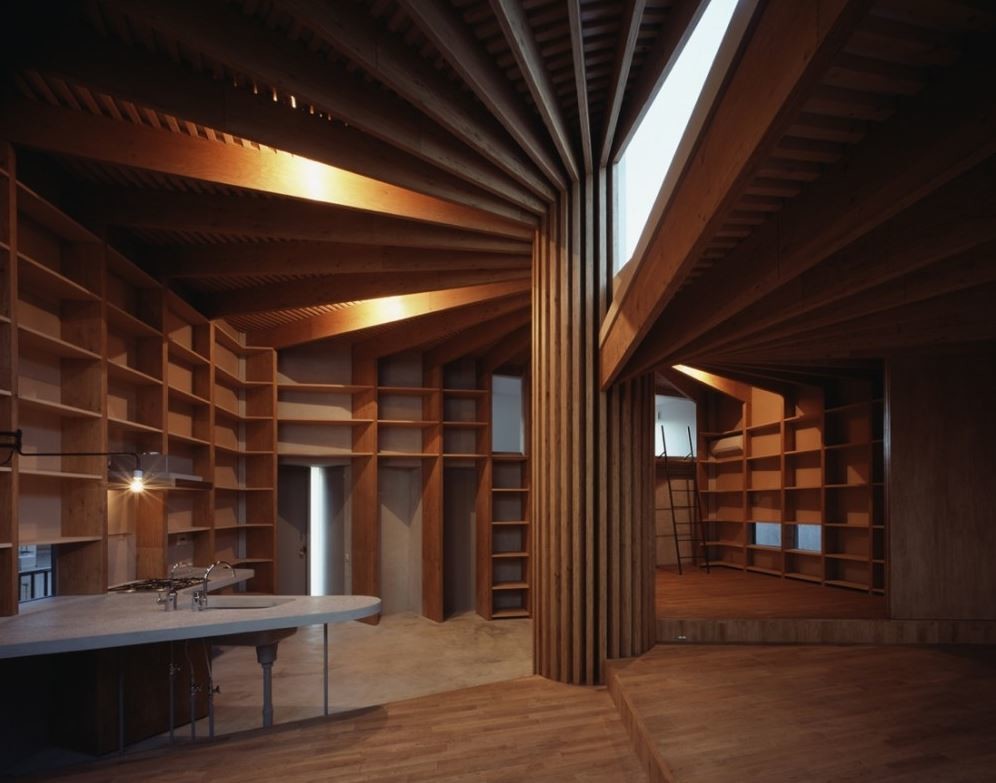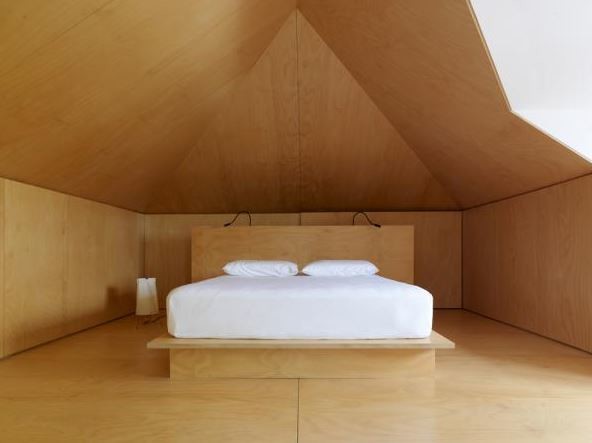Plywood is used extensively in design and construction because it is dependable, cost effective, has low embodied energy and a distinctive visual warmth and swirling grain.
Comprising thin layers of wood veneer bonded together, improvements in bonding and tensile strengths has also seen plywood increasingly specified for structural bracing and, as seen in Melbourne, used structurally in high-rise buildings.
The following list looks at 11 ways you can use plywood, and is divided into parts and buildings subheadings. The projects listed use plywood in a variety of grades, veneer-type, colour and finishes as the dominant building material.
PARTS:
Floors and Walls and Ceilings:
![]()
![]()
Architecture studio NAAD gutted a 100-year-old house in Kyoto and re-skinned its interior in plywood to create a dwelling that is designed to look incomplete.
Sheets of pale plywood were added by NAAD to the walls, floors and ceilings of the timber-framed property. Photography by Keishiro Yamada.
Stairs:

![]()
^England’s Eldridge Smerin architects chose plywood riser and soffits for this staircase at their Belsize Park House in London, England (picture above). The entire house was awarded a Royal Institute of British Architecture award in 2009. Photography by Marcus Peel Photography.
(Left) Buj+Colón Arquitectos incorporated storage space into plywood structures for this staircase design at a Madrid apartment. It features deep treads and no balustrade and provides access to the upper floor bedroom. Photography by Elena Almagro.
Exposed beams:


Japanese firm Mount Fuji Architects Studio created Tree House from a series of plywood arches gradually rising in height as they pivot around a central column.
The arch-shaped “column-beam” frame structure is made by LVL/Laminated Veneer Lumber in 51 mm thickness and is rotated in the regular angle of 11.25 degree (360 degree/32 frames) to form its shape.
Kitchens:



While the standout feature of Hello House by OOF! Architecture is its exterior wall, its plywood interior kitchen must come a close second. Plywood cabinetry and sideboards contrast with polished concrete and brick walls to add warmth to the otherwise sparse interior space. Photography by Nic Granleese
Bedroom:


Highly Commended at the 2011 Houses Awards, architect Jason Gibney created this Sydney apartment for his family. The completely plywood clad bedroom is a feature of the home that uses the material extensively throughout. Photography by Justin Alexander
Structural:

V-beam roof trusses of sandwiched 62-millimeter plywood panels run parallel along the length of this Japanese house by mA-type Architects. Plywood is also used to line the eaves, and ceilings inside the house.
BUILDINGS
Education:


Designed by Melbourne architect John Wardle and Boston’s architect Nader Tehrani, the new Melbourne School of Design (MSD) at Melbourne University comprises sweeping spaces and complex forms. This includes a vertical tier of three plywood-clad classrooms, suspended from glulam timber beams, piercing the volume of the atrium. Photography by Peter Bennetts and John Gollings.
Shop:


Baker D. Chirico in Carlton Melbourne comprises undulating plywood shelving system and a custom timber counter that extends to wrap the ceiling. The project was designed by March Studio and was crafted using a CNC router. Photography by Peter Bennetts.
House:


New Zealand architect Davor Popadich originally designed his own home with a completely plywood interior for aesthetic purposes. However on closer inspection, following budget issues, it also became clear that it was a cost effective solution that was cheaper than plasterboard because it didn’t have to be plastered and painted following installation. Photography by Simon Devitt.
Office:


Australian architect Max Pritchard designed Tree Top Studio over a decade ago as an office extension for his own home. Measuring just four metres in diameter with 25sqm of floor space, the building is wrapped in golden plywood sheeting, with hardwood battens covering sheet joints and expressing the timber frame structure of vertical wall studs and radiating roof beams. Photography by Sam Noonan

